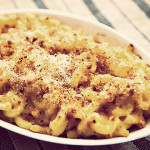In this third part of my US-style barbecue, after focussing on side dishes in the first two articles, we finally get to cook the centre of our feast: smoky, tender pulled pork with a Kansas-city style barbecue sauce.
This is the second in a series of articles about American-style barbecue and we continue today with two more side dishes, cornbread and shredded Brussels sprouts with bacon. They both work very well with all types of barbecue and are also happy accompanying any kind of roast meat, for that matter. In the next column, I will share with you my recipe for tender, juicy pulled pork and my very own Kansas City-style barbecue sauce!
 Now that the days are longer and starting to be filled with sunlight once again, it is natural to think about outdoor cooking again and for the barbecues to make their first appearance. In most places around the world, the word ‘barbecue’ is used to describe cooking over an open fire or gas grill; typically a fast, high-heat method. In the USA, however, the word is used to describe a much slower way of cooking that uses an indirect source of heat (typically a wood or charcoal fire which adds smoke to the process) and produces very complex flavours and aromas.
Now that the days are longer and starting to be filled with sunlight once again, it is natural to think about outdoor cooking again and for the barbecues to make their first appearance. In most places around the world, the word ‘barbecue’ is used to describe cooking over an open fire or gas grill; typically a fast, high-heat method. In the USA, however, the word is used to describe a much slower way of cooking that uses an indirect source of heat (typically a wood or charcoal fire which adds smoke to the process) and produces very complex flavours and aromas.
 One of the advantages of living in a small city like Groningen is that you can get to know the people responsible for the food you purchase and eat. One of the most interesting developments in the Groningen food scene the last few years was the opening of the Stadsbakker Meijer, near the Harmonie building. The owner/baker Wim Meijer has been offering consistently excellent products, using both traditional and innovative recipes and processes. So it came as little surprise when he agreed to help me out on this new little project, the development of ready-to-use, bake-at-home pizza dough!
One of the advantages of living in a small city like Groningen is that you can get to know the people responsible for the food you purchase and eat. One of the most interesting developments in the Groningen food scene the last few years was the opening of the Stadsbakker Meijer, near the Harmonie building. The owner/baker Wim Meijer has been offering consistently excellent products, using both traditional and innovative recipes and processes. So it came as little surprise when he agreed to help me out on this new little project, the development of ready-to-use, bake-at-home pizza dough!
Trying to predict what the future may bring is a fool’s errand. Better, I think, to take the bull by the horns and shape the future into a world we can thrive in, than wait for it to magically conform to our expectations and needs. Many of the challenges humans face today (and will continue facing for a long while), such as overpopulation, the diminution of natural resources, global warming, increases in wealth inequalities, and the increase in the price of food are interwoven. One may find this complexity cause for giving up, but I feel the opposite: even small changes in our daily lives can lead to significant changes, given broad enough adoption. It is both frightening and liberating to realise the extent of control we can exert over our environment (by which I mean everything around us, not just the natural environment) and my hope is that we can recognise this power and use it judiciously.
Today, rather than focusing on a single ingredient or recipe, we look at regional Italian cooking, starting with Lazio, one of the regions of central Italy, which is home to the country’s capital, Rome. It is a region which is diverse in culinary bounty, with plentiful access to the Tyrrhenian Sea, open flatlands, and densely wooded, volcanic mountains. Still, many of the traditional recipes from Lazio are recipes of poverty and necessity, featuring only one or two high-quality ingredients. Such are the two recipes we are cooking here: spaghetti cacio e pepe from Rome and bucatini all’Amatriciana from the mountainous town of Amatrice. Both are primi piati, or first courses in a typical Italian meal, to follow simple antipasti (olives, a simple salad, a carpaccio, etc.) and to be followed by a heartier main course.





